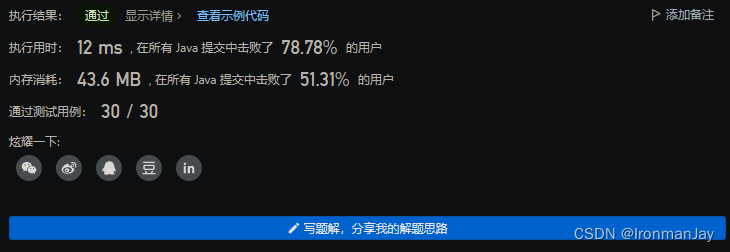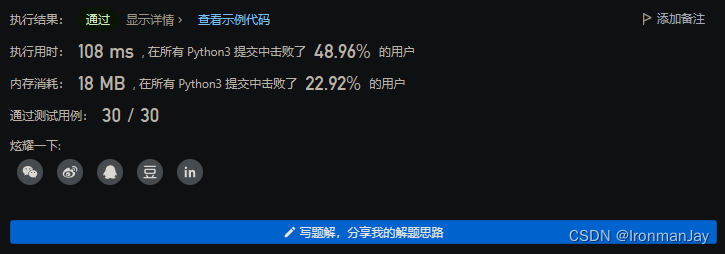一【题目类别】
- 双指针
二【题目难度】
- 中等
三【题目编号】
- 475.供暖器
四【题目描述】
- 冬季已经来临。 你的任务是设计一个有固定加热半径的供暖器向所有房屋供暖。
- 在加热器的加热半径范围内的每个房屋都可以获得供暖。
- 现在,给出位于一条水平线上的房屋 houses 和供暖器 heaters 的位置,请你找出并返回可以覆盖所有房屋的最小加热半径。
- 说明:所有供暖器都遵循你的半径标准,加热的半径也一样。
五【题目示例】
-
示例 1:
- 输入: houses = [1,2,3], heaters = [2]
- 输出: 1
- 解释: 仅在位置2上有一个供暖器。如果我们将加热半径设为1,那么所有房屋就都能得到供暖。
-
示例 2:
- 输入: houses = [1,2,3,4], heaters = [1,4]
- 输出: 1
- 解释: 在位置1, 4上有两个供暖器。我们需要将加热半径设为1,这样所有房屋就都能得到供暖。
-
示例 3:
- 输入:houses = [1,5], heaters = [2]
- 输出:3
六【解题思路】
- 本题思路不太好想,但是把逻辑理顺之后,代码并不难写
- 首先我们应该对两个数组进行排序,排序的目的是减少不必要的比较以及避免比较时出错,因为如果不排序可能会导致最短距离找不到,这个可以在纸上用笔简单画一画就明白了
- 排序之后遍历房屋数组和供暖器数组,但是两个数组遍历的方式不太一样:
- 房屋数组:从0开始遍历,遍历到数组结尾,此遍历的主要目的是从头到尾求出每个房子距离供暖器的最短距离
- 供暖器数组:从0开始遍历,遍历到数组结尾的前一个,此遍历的目的是找到距离每个房子最近的供暖器
- 遍历数组之后,我们就可以得到距离某个房子最近的供暖器了
- 但是此时我们还没有结束,我们要继续将剩下的所有房屋遍历结束
- 将所有房屋遍历结束后,我们从所有最小的距离中选出最大的距离就是我们的答案
- 最后返回结果即可
七【题目提示】
- 1 < = h o u s e s . l e n g t h , h e a t e r s . l e n g t h < = 3 ∗ 1 0 4 1 <= houses.length, heaters.length <= 3 * 10^4 1<=houses.length,heaters.length<=3∗104
- 1 < = h o u s e s [ i ] , h e a t e r s [ i ] < = 1 0 9 1 <= houses[i], heaters[i] <= 10^9 1<=houses[i],heaters[i]<=109
八【时间频度】
- 时间复杂度: O ( m l o g m + n l o g n ) O(mlogm+nlogn) O(mlogm+nlogn),其中 m m m和 n n n分别为传入的两个数组的长度
- 空间复杂度: O ( l o g m + l o g n ) O(logm+logn) O(logm+logn),其中 m m m和 n n n分别为传入的两个数组的长度
九【代码实现】
- Java语言版
class Solution {
public int findRadius(int[] houses, int[] heaters) {
Arrays.sort(houses);
Arrays.sort(heaters);
int res = 0;
for(int i = 0,j = 0;i<houses.length;i++){
int curDis = Math.abs(houses[i] - heaters[j]);
while(j < heaters.length - 1 && Math.abs(houses[i] - heaters[j]) >= Math.abs(houses[i] - heaters[j + 1])){
j++;
curDis = Math.min(curDis,Math.abs(houses[i] - heaters[j]));
}
res = Math.max(curDis,res);
}
return res;
}
}
- C语言版
int compare(const void *a,const void *b)
{
int *pa = (int*)a;
int *pb = (int*)b;
return *pa - *pb;
}
int findRadius(int* houses, int housesSize, int* heaters, int heatersSize)
{
qsort(houses,housesSize,sizeof(int),compare);
qsort(heaters,heatersSize,sizeof(int),compare);
int res = 0;
for(int i = 0,j=0;i<housesSize;i++)
{
int curDis = fabs(houses[i] - heaters[j]);
while(j < heatersSize - 1 && fabs(houses[i] - heaters[j]) >= fabs(houses[i] - heaters[j + 1]))
{
j++;
curDis = fabs(houses[i] - heaters[j]);
}
res = fmax(res,curDis);
}
return res;
}
- Python语言版
class Solution:
def findRadius(self, houses: List[int], heaters: List[int]) -> int:
houses.sort()
heaters.sort()
lenHouses = len(houses)
lenHeaters = len(heaters)
res = 0
j = 0
for i in range(0,lenHouses):
curDis = abs(houses[i] - heaters[j])
while j < lenHeaters - 1 and abs(houses[i] - heaters[j]) >= abs(houses[i] - heaters[j + 1]):
j+=1
curDis = abs(houses[i] - heaters[j])
res = max(res,curDis)
return res
- C++语言版
class Solution {
public:
int findRadius(vector<int>& houses, vector<int>& heaters) {
sort(houses.begin(),houses.end());
sort(heaters.begin(),heaters.end());
int res = 0;
for(int i = 0,j=0;i<houses.size();i++)
{
int curDis = abs(houses[i] - heaters[j]);
while(j < heaters.size() - 1 && abs(houses[i] - heaters[j]) >= abs(houses[i] - heaters[j + 1]))
{
j++;
curDis = abs(houses[i] - heaters[j]);
}
res = max(res,curDis);
}
return res;
}
};
十【提交结果】
-
Java语言版

-
C语言版

-
Python语言版

-
C++语言版
